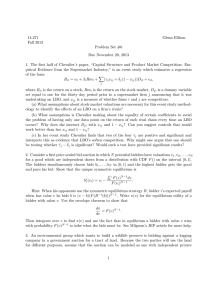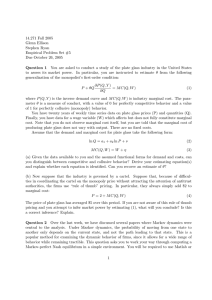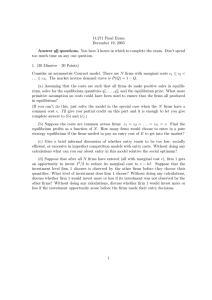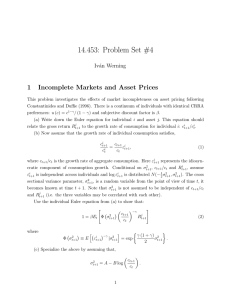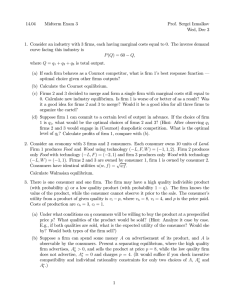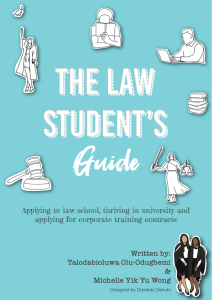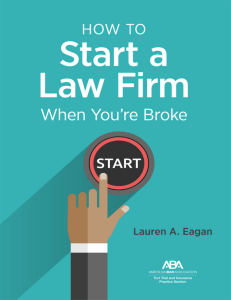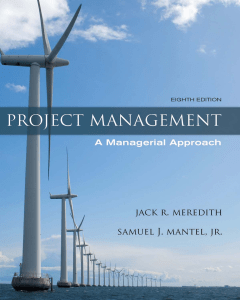14.271 Glenn Ellison Fall 2005 Stephen Ryan
advertisement
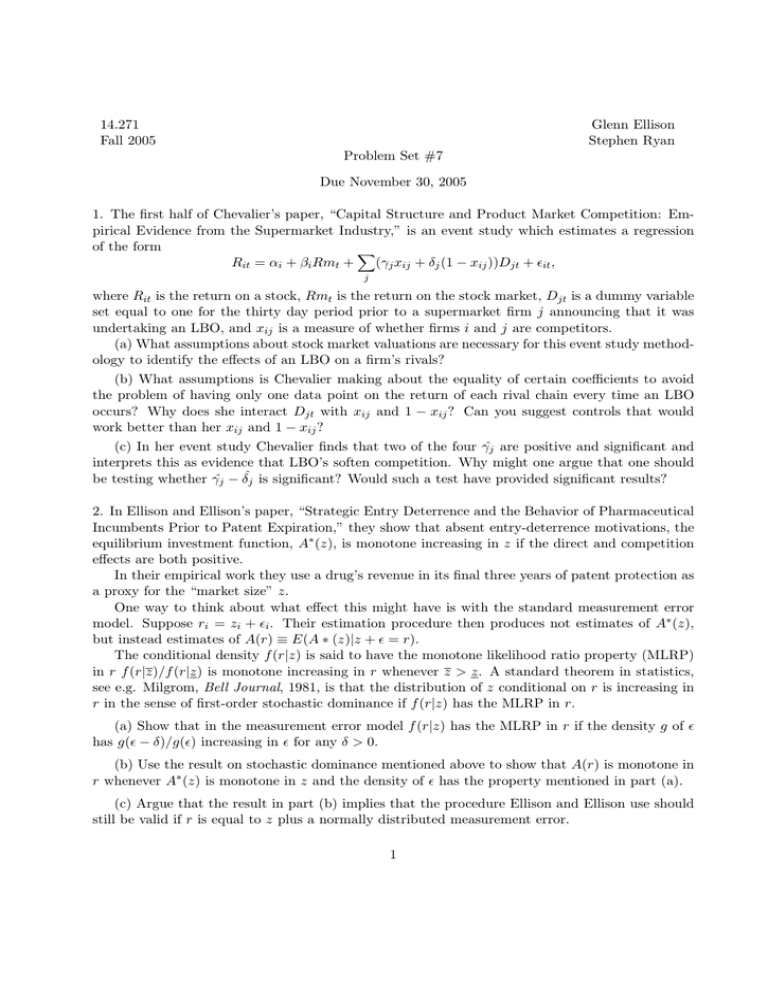
14.271 Fall 2005 Glenn Ellison Stephen Ryan Problem Set #7 Due November 30, 2005 1. The first half of Chevalier’s paper, “Capital Structure and Product Market Competition: Em­ pirical Evidence from the Supermarket Industry,” is an event study which estimates a regression of the form � Rit = αi + βi Rmt + (γj xij + δj (1 − xij ))Djt + �it , j where Rit is the return on a stock, Rmt is the return on the stock market, Djt is a dummy variable set equal to one for the thirty day period prior to a supermarket firm j announcing that it was undertaking an LBO, and xij is a measure of whether firms i and j are competitors. (a) What assumptions about stock market valuations are necessary for this event study method­ ology to identify the effects of an LBO on a firm’s rivals? (b) What assumptions is Chevalier making about the equality of certain coefficients to avoid the problem of having only one data point on the return of each rival chain every time an LBO occurs? Why does she interact Djt with xij and 1 − xij ? Can you suggest controls that would work better than her xij and 1 − xij ? (c) In her event study Chevalier finds that two of the four γˆj are positive and significant and interprets this as evidence that LBO’s soften competition. Why might one argue that one should be testing whether γˆj − δˆj is significant? Would such a test have provided significant results? 2. In Ellison and Ellison’s paper, “Strategic Entry Deterrence and the Behavior of Pharmaceutical Incumbents Prior to Patent Expiration,” they show that absent entry­deterrence motivations, the equilibrium investment function, A∗ (z), is monotone increasing in z if the direct and competition effects are both positive. In their empirical work they use a drug’s revenue in its final three years of patent protection as a proxy for the “market size” z. One way to think about what effect this might have is with the standard measurement error model. Suppose ri = zi + �i . Their estimation procedure then produces not estimates of A∗ (z), but instead estimates of A(r) ≡ E(A ∗ (z)|z + � = r). The conditional density f (r|z) is said to have the monotone likelihood ratio property (MLRP) in r f (r|z)/f (r|z) is monotone increasing in r whenever z > z. A standard theorem in statistics, see e.g. Milgrom, Bell Journal, 1981, is that the distribution of z conditional on r is increasing in r in the sense of first­order stochastic dominance if f (r|z) has the MLRP in r. (a) Show that in the measurement error model f (r|z) has the MLRP in r if the density g of � has g(� − δ)/g(�) increasing in � for any δ > 0. (b) Use the result on stochastic dominance mentioned above to show that A(r) is monotone in r whenever A∗ (z) is monotone in z and the density of � has the property mentioned in part (a). (c) Argue that the result in part (b) implies that the procedure Ellison and Ellison use should still be valid if r is equal to z plus a normally distributed measurement error. 1 (d) Give an example to show that A(r) can be nonmonotone in r even though A(z) is monotone in z if the measurement error is not normally distributed. (Hint: pick simple but very atypical distributions for z and �. 3. Consider a two period model of limit pricing under incomplete information where an incumbent produces an observable level of output in period 1, and a potential entrant may enter in period 2 conditional on the observed period 1 output of the incumbent. The incumbent has a constant marginal cost of either c1 or c2 where c2 > c1 . The potential entrant does not observe the incum­ bent’s marginal cost, but knows that if he enters his marginal cost wil be identical to that of the incumbent. Entry involves a sunk fixed cost of E. Upon entering the entrant learns his marginal cost and the two firms engage in Cournot competition. The inverse demand curve in each period is P (Q) = a − bQ, where Q is the total output in that period. The discount factor of the incumbent is δ. Assume that (a − c2 )2 (a − c1 )2 >E> 9b 9b and that (a − c1 )2 (a − bq2m − c1 )q2m + δ(a − bq1m − c1 )q1m > (a − bq1m − c1 )q1m + δ 9b i where qim = a−c 2b . What is the set of separating Perfect Bayesian Equilibria for this model? What is the effect of signaling on first­period welfare? How does this compare to Milgrom and Roberts’ results. 4. Consider the following four stage game involving two firms. Initially firm 1 is a monopolist. In the first stage, it sets price p1 and receives profits π11 = (p1 − c)D(p1 ). The demand function is initially unknown to the firms. They share a common prior, believing that demand is θd(p) with with probability q and θd(p) with probability 1 − q. Assume θ > θ. Demand is the same in both periods of the game. Firm 1 learns the true value of θ after the first stage. Firm 2, however, does not observe firm 1’s demand. In the second stage firm 1 has the option of bulding a fire with $100 bills so that he may reduce his profits to any level he likes. At the end of the second stage firm 1 is required by law to disclose its remaining profits (but not the amount of money it burned). In the third stage firm 2 may enter the market at a cost of E > 0. Finally in the fourth stage the firms compete earning profits π1m (θ) and 0 if firm 2 didn’t enter and π1D (θ) and π2D (θ) if firm 2 did enter. (a) If qπ2D (θ) + (1 − q)π2D (θ) > E, show that there is no perfect Bayesian equilibrium where firm 1 burns (θ − θ)d(p1 ) in the high demand state to pretend that it is low demand state. (b) Find sufficient conditions for the existence of a separating PBE where firm 1 burns money only when demand is low. How does the welfare analysis of such an equilibrium differ from that of Fudenberg and Tirole’s signal­jamming model. 5. Consider a first price sealed bid auction in which N potential bidders have valuations v1 , v2 , . . . , vN for a good which are independent draws from a distribution with CDF F () on the interval [0, 1]. The bidders simultaneously choose bids b1 , . . . , bN in [0, 1] and the highest bidder gets the good 2 and pays his bid. Show that the unique symmetric equilibrium is b∗i (vi ) � vi = vi − 0 F (z)N −1 dz . F (vi )N −1 Hint: When his opponents use the symmetric equilibrium strategy B, bidder i’s expected payoff when has value v he bids b is (v − b)(F (B −1 (b)))N −1 . Write π(v) for the equilibrium utility of a bidder with value v. Use the envelope theorem to show that dπ = F (v)N −1 . dv Then integrate over v to find π(v) and use the fact that in equlibrium a bidder with value v wins with probability F (v)N −1 to infer what the bids must be. See Milgrom’s JEP article for more help. 6. An environmental group which wants to build a wildlife preserve is bidding against a logging company in a government auction for a tract of land. Because the two parties will use the land for different purposes, assume that the auction can be modeled as one with independent private values. Assume that it is common knowledge that the environmental group’s valuation for the land, ve , is drawn from a uniform distribution on [0, 2], and that the logging company’s valuation, v� is drawn from a uniform distribution on [1, 2]. (a) Find the equilibrium strategies and the probability with which each party wins the tract in a second price sealed bid auction. What is the government’s expected revenue? Would you expect a first price sealed bid auction to raise more, less, or the same amount of revenue (in expectation)? (b) Suppose that the government uses a first price auction, and that before the auction takes plase the logging company has the opportunity to install new machinery at a nearby mill which would reduce the marginal cost of processing timber from this tract. Describe how the decision to install the machinery might depend on whether or not the environmental group is able to observe that the new machinery has been installed. 3

